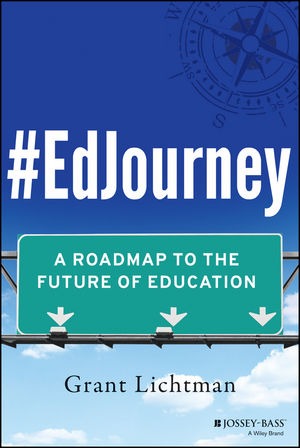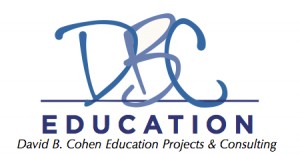A couple years ago, as I was in the dreaming phase of the writing project I’m now carrying out, I saw a TEDx talk by Grant Lichtman (embedded video below) which described an extended road trip to visit and learn from 60 innovative schools around the country. While part of me reacted with disappointment that my project wouldn’t seem as original, I was encouraged to find that someone else thought it was worthwhile to undertake similar work, and to think that there might be an audience for what we can learn through such an endeavor.
 Grant Lichtman’s book, #EdJourney: A Roadmap to the Future of Education, came out near the time I started my own project, and I’ve been meaning to share my thoughts about the book for a while now. I read it over the course of a couple of my own road trips, and found it quite useful in sharpening my own thinking about my work as I considered the overlap and the differences in our approaches.
Grant Lichtman’s book, #EdJourney: A Roadmap to the Future of Education, came out near the time I started my own project, and I’ve been meaning to share my thoughts about the book for a while now. I read it over the course of a couple of my own road trips, and found it quite useful in sharpening my own thinking about my work as I considered the overlap and the differences in our approaches.
Coming from a background that includes experience in independent school leadership, consulting, and private industry, Lichtman stresses at the outset of the book that he’s interested in the broad picture of innovation in school organizations and cultures. It’s not a book about technology in schools, or aimed at pushing any particular form of teaching or school governance. He takes as a given certain understandings of “21st century skills” and the need for schools to change. The focus of the book, then, becomes highlighting some of the shared qualities and practices among a variety of innovative schools around the country.
For readers who are ready for that change, or already helping bring it along, the book will certainly have a strong appeal, with ample details and examples to consider. Lichtman spoke with administrators, teachers, students, and a variety of other people along the way. Having a prior and longstanding interest in the book’s topic, I was already familiar with a number of the schools and individuals highlighted in #EdJourney, though most were new to me. There are all sorts of schools in the mix – public, independent (including parochial schools), charter schools, magnet program. Lichtman argues that lessons that can be derived from these schools can be applied in some form at any school; for the most part he doesn’t concern himself with the policy and politics of education reform.
I see the logic in that approach: it’s too easy to get caught up in those debates, which are of course essential, even existential. But they are outside the focus of the book, and potentially, an easy “out” for readers or stakeholders facing the prospect of uncomfortable changes. Lichtman understands the reticence people feel concerning change, and in the book’s introduction (xii) draws the distinction between what’s hard (giving birth, being a single parent, fighting a war) and what’s uncomfortable (changing school curriculum, changing schedules, giving students more autonomy).
Still, there are readers for whom I imagine that distinction might feel less useful, too easily drawn from an outside perspective. Fair enough. I know the feeling: having someone press you to change when you’re barely hanging on to what you have rarely produces the desired effect. But ultimately, change in education is inevitable, and driving key aspects of the change is preferable to riding it out. Frank conversations are important for school systems seeking to improve, and frank conversations should be informed conversations – even when the information comes from a school or sector that seems dissimilar. I have to admit, Lichtman struck a nerve with this observation:
Schools are mentally as well as physically isolated. Few teachers visit other schools or collaborate frequently with teachers or administrators from other schools or with the many knowledge creators and managers in the community. Few teachers make lasting connections with colleagues in other parts of the world. Few teachers are familiar with the latest research…. They don’t read scholarly journals. Most don’t follow educational blogs or engage in professional development via social media…. (90).
It stings a bit to hear that, and I would guess that readers of this blog and this review might be among the “few” who do what Lichtman mentions in that excerpt. But it rings true to me as a fair criticism of our current situation in American schools overall.
So let’s change! Just as we expect students to make changes based on feedback and constructive criticism, we need to be open to changing schools. We expect students to take chances, occasionally make mistakes, learn from their mistakes and improve. Let’s do the same with schools. #EdJourney would provide a great touchstone text for education stakeholders ready to discuss and then act on those principles. Lichtman understands the obstacles well, and early on he identifies
“four obstacles repeated most frequently that appear to present a truly existential challenge to a school’s ability to change what it does:
- Use of time
- Developing people and their ability to change
- Leadership
- Organizational structures” (2).
Lichtman’s book begins then with an effort to describe and explain these four primary obstacles, and five secondary obstacles as well. In the latter chapters of the book, he pulls together the common qualities of innovative schools. They are: dynamic, adaptable, permeable, creative, and self-correcting. As he proceeds through examples of schools that have made strides in these areas, Lichtman does not neglect to address the real concerns and challenges from outside “drivers” such as cost, state policies, standards, or college admission requirements. For me, that’s an important quality of the book, recognizing that there are barriers to imitation or adoption of certain practices; in fact, Lichtman observes multiple times that successful change comes from a creative rather than duplicative process: your school’s transformation should be designed by your school community, and it will naturally adapt to your local conditions.
In fact, “natural” processes are central to Lichtman’s concept. He acknowledges that he’s not the first to contrast the school-as-assembly-line model with the natural world, and then argues:
We cannot tweak the assembly line and hope it will operate like a natural ecosystem; that is foundationally a square-peg-and-round-hole problem. We have to reimagine learning as an evolving natural ecosystem and then allow ecosystem-like processes to take over what is now a rigid, highly controlled, repetitive, creativity-killing assembly line. (181)
If there’s one area where I’d have liked a few more answers or details in the book, it would be around changes in the substance of student knowledge. New approaches to learning can’t be cost-free compared to the most effective traditional models; there must be some trade-offs, I assume. I understand and embrace the benefits of what Lichtman endorses, and at the same time, I think there is a body of useful, vital knowledge in our traditional academic disciplines. So, to invent an example, a high school’s students might design a challenging, interdisciplinary project about World War II. It might involve literature and the arts, primary sources from history, interviews with local veterans, physics and chemistry, dialogue with students in nations formerly Axis and Allied. You’d love every minute of this project – but would we have a problem with this model of studying World War II if students ended up unfamiliar with topics such as Japanese internment, causes of the Holocaust, the Marshall Plan or the Manhattan Project? I’m well aware of the downside of teaching for “coverage” – I passed the A.P. European History exam in high school and quickly forgot all but the most general of topics. Still, as a high school teacher, I’d have been interested in more curricular descriptions and discussion.
So, if it’s not too early for some recommended summer reading, I’d suggest picking up a copy of #EdJourney, (and check out Lichtman’s blog as well). But I’d also suggest that you don’t read it the way I did – alone. Be sure to read it with a friend or colleague, or group, and start those conversations about the future of schools and education. If you’ve already read the book, or have other thoughts on the topic, I’d love to hear your thoughts in the comments below.
